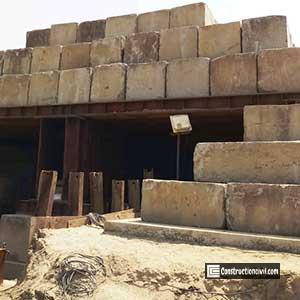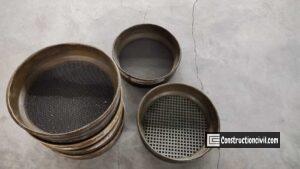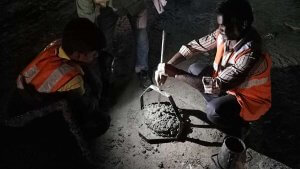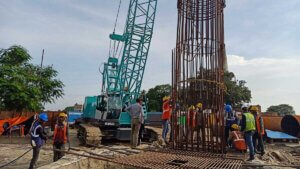Two types of Pile load tests are generally conducted at the site, initial and routine, to determine load-carrying capacity and get an idea of the suitability of the piling system. The mode of loading can be vertical, lateral and pull-out depending upon the site requirement. With the help of a routine pile load test, we can check safe load capacity as determined from static analysis. In the case of the initial pile load test procedure, the applied load reaches 2.5 times the safe estimated load, and the routine pile load test, the applied load, reaches 1.5 times the safe estimated load.
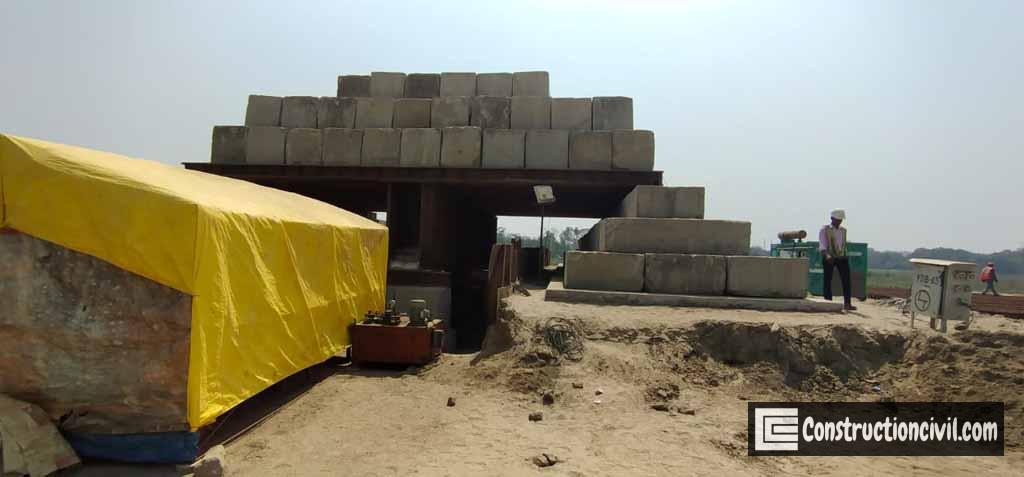
Also, Read: Bentonite Uses in Piling – Bentonite Slurry Preparation and Recycling
Equipment for Kentledge Pile Load Test:
The following types of equipment and machinery are required for Vertical Pile Load Test Procedure.
- Excavator (JCB 3D or equivalent) – 1No
- Tipper (10MT for material transportation) – As per lead
- Mobile hydraulic crane – 1No(Capacity based on lifting requirement)
- Welding machine and DG (for test arrangements) – 1 No
- Hydraulic Jacks
- Hydraulic pump or power pack
- Calibrated Pressure Gauge
- Calibrated dial gauges with least count 0.01 mm
Materials for Kentledge Pile Load Test :
- Concrete blocks or empty cement jumbo bags filed with local earth/sand as per the availability at the site.
Pile Load Test Arrangement:
The details of the kentledge, kentledge platform and overall arrangements for static pile load tests should be as per approved drawings issued by authority.
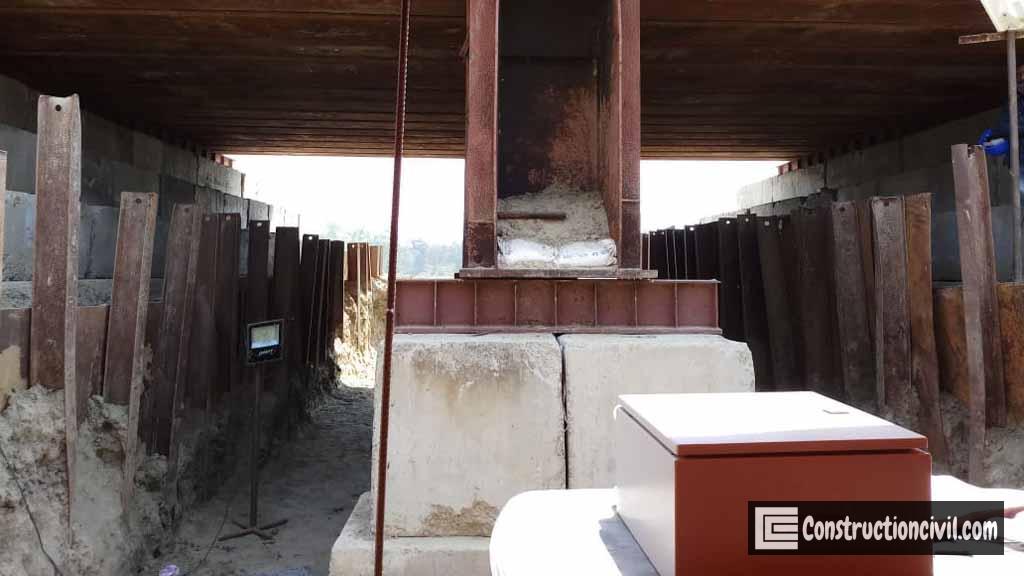
Also, Read: 4 Important Bentonite Test for Piling – Equipment & Procedure
Preparation for initial Pile Load Test:
- Concrete cubes were taken during the test pile’s concreting to be tested for seven days and 28 days.
- Compile concrete cube test results and ensure that concrete has gained the desired strength.
- Excavate around the test pile up to the bottom of the pile head to be built.
- The concrete above the pile head bottom level shall be dismantled, and the pile head will be constructed as per GFC/approve drawing.
- After the pile head built up, Place 2 Nos of 32 mm or higher thick MS plates on top of the surface of the pile head in a neat horizontal manner.
- The horizontal alignment of this plate shall be checked with the help of the spirit level.
- The arrangement will be made to support the main girders on either side of the test pile.
- The arrangement will be made to support secondary girders on either side of the pile to be tested.
- Place the required number of suitable capacity hydraulic jacks in position.
- Place a standard MS stool on jacks.
- Place main girders on MS stool with its centre concentric with the pile to be tested.
- Place secondary girders on the main girder, the group centre concentric with the main girders and pile.
- Place thick wooden planks spanning across secondary girders as the platform.
- Spread empty cement bags/thick polythene sheet in two layers on the wooden platform.
- Place empty cement jumbo bags filed with local earth/sand as the case may be.
- The actual number of bags and the kentledge platform weight should be equivalent to the required kentledge load.
- Kentledge arrangement load shall be 25% higher than the test load.
- Place the two supports of datum bars(reference beam) firmly in the ground and make suitable arrangements like brick pillars around these supports so that ends of datum bars do not get disturbed.
- Fix angles at suitable places to these reference beams/datum bars to fix strain/dial gauges shall be arranged. So, settlement can be measured easily and as far as possible without any resetting of dial gauges.
- Connect all hydraulic jacks with suitable manifolds to a standard hydraulic pump or power pack. A properly calibrated pump or power pack, a pressure gauge to be connected to the hydraulic system.
- Pile load test is commenced when it is confirmed that pile head concrete has achieved stipulated strength.
Also, Read: Laboratory Test on soil – Procedures and Objective
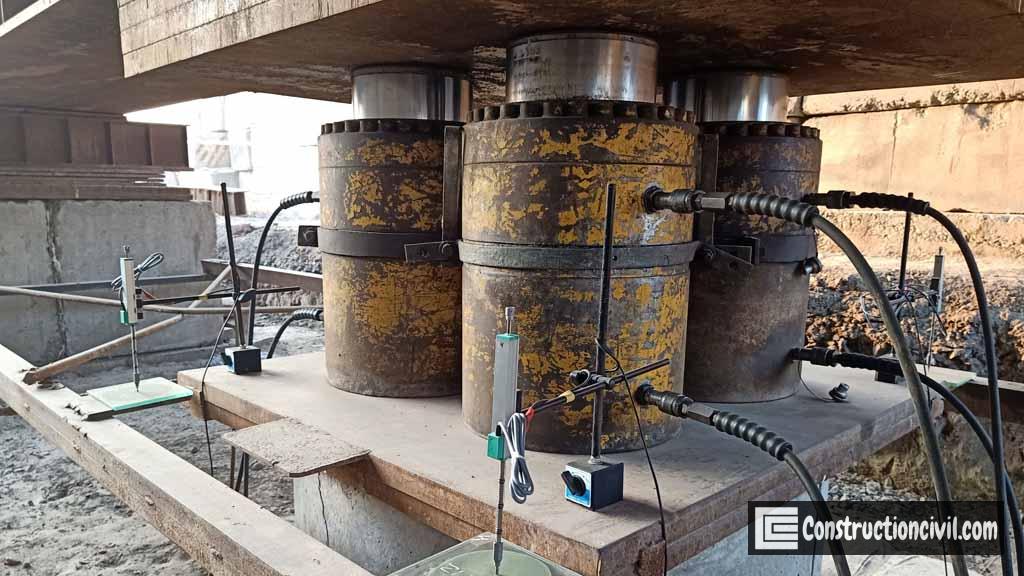
Also, Read: Construction of Pile Foundation by Direct Mud Circulation(DMC) method
Pile Load Test Procedure – Kentledge Method :
- Apply a minimum seating load and release it before starting the actual load test. The above will ensure the proper functioning of hydraulic jacks and load test kentledge/girder arrangement.
- Fix a required number of dial/strain gauges as proposed in the positions(at least two).
- Apply the load to pile at an equal increment of 20% of the design load.
- The load increment shall be adjusted to the nearest least count of the hydraulic jacks’ pressure gauge and ram area.
- Record the settlement after each increment of test load with an interval of 5 minutes, 15 minutes, 30 minutes, 60minutes, 120 minutes from the time of application of load.
- In this pile load test method, each stage of loading shall be maintained until the pile top’s rate of movement is not more than 0.2 mm/h or until two hours have elapsed, whichever is earlier subject to a minimum of one hour.
- Settlement observations in mm from the time of application of load shall be recorded in a tabular proforma as per the standard quality procedure. In this manner, settlement to be recorded for every individual load increment.
- After application of the total test load, it will be held constant for 24 hours. Total pile settlement at the end of the test load application shall be recorded, and the load test results will be analyzed.
- After completing the pile load test, remove the strain/dial gauges, hydraulic jacks with the power pack, connections to datum bars etc., from the top of the test pile. Remove the load test arrangements like kentledge load MS girders, datum bars pillars etc., in a Symmetry.
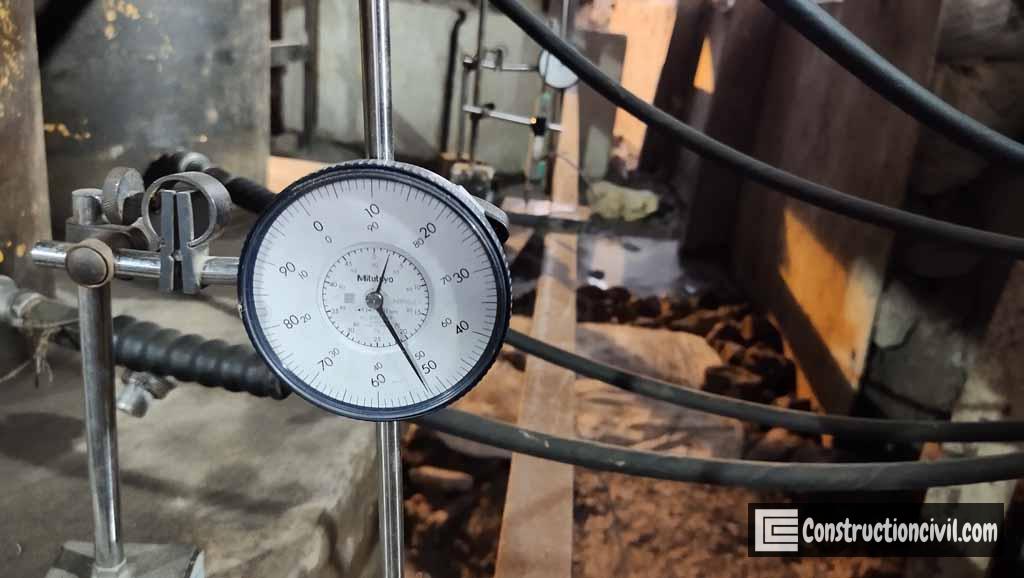
Also, Read: Dynamic Load Test on Piles – Objective, Procedure & Analysis
Safe Vertical Load on a Single Pile:
The safe load on the single pile for the pile load test shall be evaluated on the basis of the following two criteria, clause 7.1.5 of IS 2911 (Part 4): 2013
For piles up to 600mm diameter:
- 2/3 of the final load at which the total displacement attains a value of 12 mm unless otherwise specified.
- 50% of the final load at which the total displacement equals 10% of the pile diameter in uniform diameter piles and 7.5% of bulb diameter in case of under-reamed piles.
For piles more than 600mm diameter:
- 2/3 of the final load at which the total displacement attains a value of 18 mm or a maximum of 2% of pile diameter, whichever is less unless otherwise specified.
- 50% of the final load at which the total displacement equals 10% of the pile diameter in uniform diameter piles and 7.5% of bulb diameter in case of under-reamed piles.
The objective of Pile Load Test :
- The average settlement of the pile under each loading shall be calculated from the applied load, time, and pile settlement observations.
- Graph of load v/s settlement shall be prepared on the basis of these vertical pile load test observations.
- The total settlement of pile, elastic rebound of the pile, and net settlement of pile shall be calculated from the load test results.
- From the results of the load v/s settlement curve, safe load on the pile shall be evaluated.
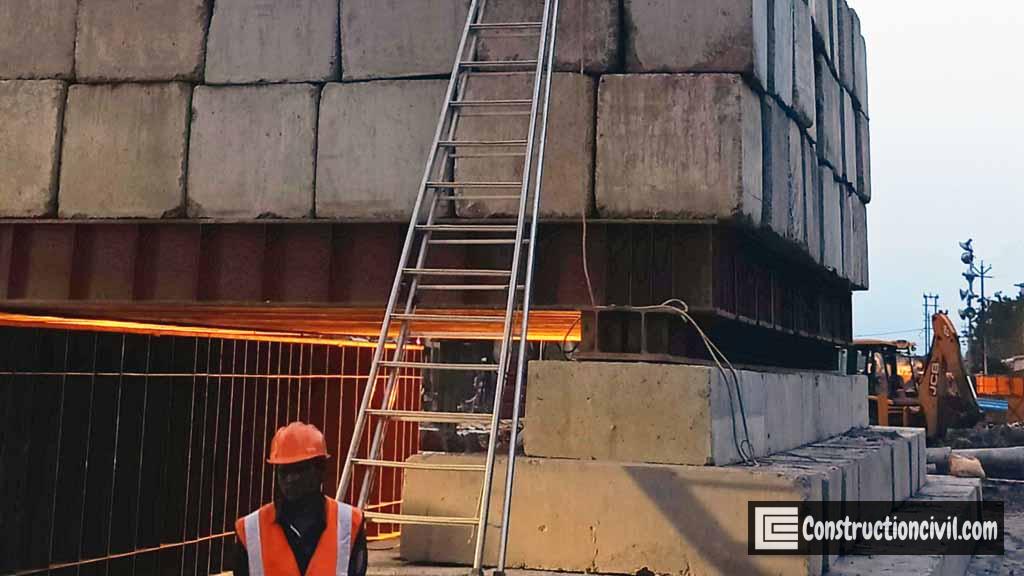
Also, Read: Lateral Load Test Pile – General Arrangement & Procedure
Safety and Quality Control:
General Safety Arrangements for Vertical Pile Load Test:
- All employees, workers and labour of contractor and its subcontractor engaged for work shall be wearing proper PPE before entering the site. Induction training shall be given to all workmen before engaging to work at the site.
- Barricading shall be completed to cover the entire length of the working area. The barricading shall be as per the approved scheme Painting of barricading shall be done with an approved colour scheme for prominent visibility.
- All the Vehicles engaged in the work shall be fitted with proper indicator systems.
- Reverse light, rearview mirror, and reverse horn shall be fitted with all the vehicles.
- Break, Steering condition, and tire pressure shall be checked periodically.
- Driver and operator shall not be deployed to work when he is not fit mentally and physically.
- Proper caution boards and flag boys shall be available to caution the vehicle movement at loading and unloading points.
- Unauthorized persons and visitors should not be permitted within the Hard Hat Area.
- Periodic training shall be given to drivers, helpers, bank men and flag boys.
- Toolbox talks shall be carried at frequent intervals by the safety Engineer.
- Proper planning of the load test activity shall be done before the start of work.
- Proper illumination shall be provided during the night shift.
- Good housekeeping shall always be maintained nearby the test area to prevent any hazards.
- Any lifting equipment shall be engaged in work after proper checking and load testing as per relevant requirement.
- Routine maintenance for all lifting equipment/devices deployed at the site shall be done, and Record shall be maintained in a prescribed format.
Also, Read: Integrity Test of Pile – Purposes, Procedure & Limitations
Also, Read: Plate Load Test for Soil – Procedure and Limitation
